“Rogue Planet”
Written by Rick Berman & Brannon Braga & Chris Black
Directed by Allan Kroeker
Season 1, Episode 18
Production episode 018
Original air date: March 20, 2002
Date: unknown
Captain’s star log. Archer is reluctantly posing for photographs that Tucker is taking for the portrait artist back on Earth who will be painting Archer’s portrait in Starfleet HQ. Reed interrupts the photo-shoot to announce that they’ve found a rogue planet, which comes to Archer as a great relief. This is a planet that broke free of its star and is floating through interstellar space.
The planet has underground heat springs that provide a Class-M atmosphere, er, somehow, and they also find a ship on the world—but no life signs. Archer, T’Pol, Reed, and Sato go down in a shuttlepod with flashlights and night-vision single-eye goggles and eventually come across three dudes. They’re called Eska, and our heroes are able to communicate with them pretty much instantaneously, thus making Sato’s presence on the landing party a total waste. To prove this point, she’s sent back to Enterprise and not seen again.
The Eska are hunters. This planet is a safari of sorts for them, as during particular times of year, a party of three is given leave to hunt some of the game on this world. Enterprise didn’t pick up their life signs because they’re wearing masking agents to hide them from their prey.
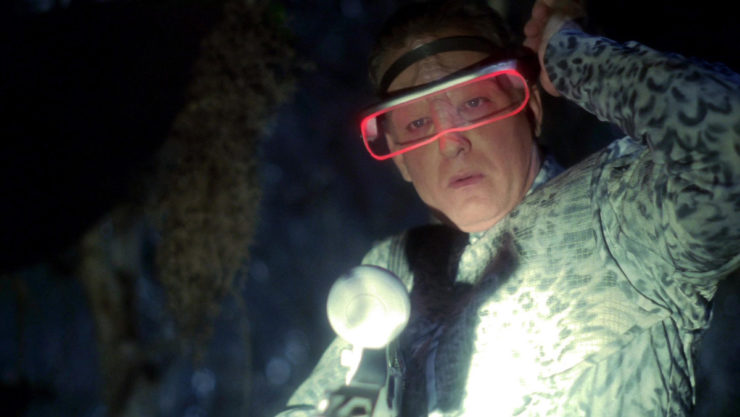
Archer asks the Eska if they can hang out with them, and they agree. When Sato returns to Enterprise, Tucker goes down to help survey the planet, while Reed asks if he can accompany the Eska on their hunt. (Reed promises Archer that he won’t kill anything, he just wants to watch the hunters in action.)
The landing party sleeps with the hunters over “night” before the hunt, and Archer is awakened by a female voice calling his name—he follows the voice and catches glimpses of a human woman in a night-dress.
Buy the Book


Until the Last of Me
The next “morning,” everyone dismisses it as a dream, though Archer thought it felt real. Archer hears and sees the woman again when he, T’Pol, and Tucker are surveying. At the same time, one of the Eska is wounded by a local animal. Archer offers Phlox’s services to patch the hunter up.
Phlox detects some bizarre skin samples on the hunter’s skin, likely from the animal that attacked him, which the Eska call a wraith. (No, not that Wraith…) The cells are in a state of chromosomal flux.
Archer continues to search for the woman, and she shows herself. She is one of the wraith that the Eska are hunting. They’re telepathic shape-changers and ask Archer for help against the Eska. She appeared to Archer as the image he had in his head of a woman from a poem his mother read to him as a child.
Returning to camp, Archer asks the Eska why they hunt here when they can hunt at home, and the Eska tell them about the wraith, and how they can get in your heads. They’re the most challenging game, though T’Pol says they sound sentient.
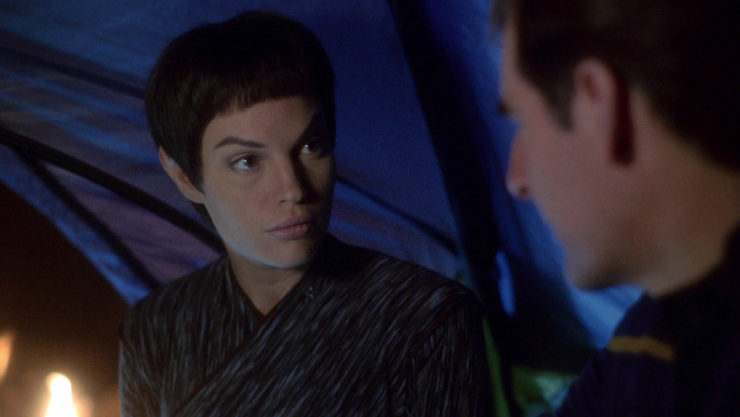
Archer returns to Enterprise with the landing party and talks it over. T’Pol points out that they can’t really stop the Eska from hunting there—even if they stop these three, they’ll just send more. Phlox, however, can create a masking agent that will keep the wraith off of the Eska’s scanning devices—it will level the playing field at least.
The Eska fail to capture the wraith, to their annoyance, and then leave the planet, wondering if the Enterprise crew was responsible. The wraith thanks Archer and Enterprise buggers off.
Can’t we just reverse the polarity? We see Starfleet’s night-vision goggles. Or, rather, goggle, since it only covers the right eye for some reason. (The Eska have night-vision visors that cover both eyes….)
The gazelle speech. Archer’s Mom read him “The Song of the Wandering Aengus” by William Butler Yeats (one of your humble rewatcher’s favorite poets) when he was a child, and the wraith looks like what little Jonny Archer imagined the fish who turned into a woman in the poem looked like.
I’ve been trained to tolerate offensive situations. T’Pol pointedly comments to Archer that he probably wouldn’t be so eager to look for the wraith alone if it was appearing as a scantily clad man. She isn’t wrong…
Florida Man. Florida Man Is Stymied In His Photographic Endeavors.
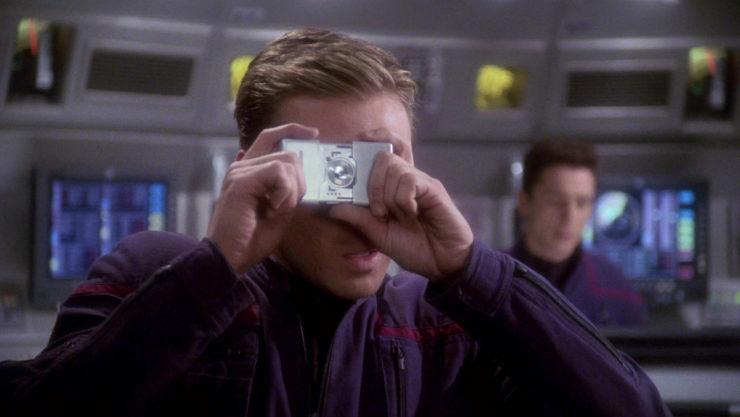
Optimism, Captain! Phlox treats the wounded Eska and comes up with a way to protect the wraith. Because he’s just that awesome…
No sex, please, we’re Starfleet. It is to the episode’s credit that the wraith does not appear as a long-lost love of Archer’s or a lust object or anything like that, though both the Eska and T’Pol make that assumption. Instead, it comes from a long-lost childhood memory involving Archer’s Mom, which is actually kind of sweet.
I’ve got faith…
“What are the chances you’d encounter a half-naked woman, who you think you know, dozens of light-years from your homeworld?”
–One of the Eska, asking Archer the good questions.
Welcome aboard. Four guests in this one, all of whom have appeared on Trek before: Stephanie Niznik (who played Perim in Insurrection) plays the wraith image Archer sees. The three Eska hunters are played by Conor O’Farrell (who played Jeff the scientist in DS9’s “Little Green Men,” and who will play D’Jamat in “Chosen Realm”), Eric Pierpoint (who played Voval in TNG’s “Liaisons,” Sanders in DS9’s “For the Uniform,” and Kortar in Voyager’s “Barge of the Dead,” and who will play Harris in this show’s fourth season), and Keith Szarabajka (who played Teero in Voyager’s “Repression“).
Trivial matters: This episode was based on a notion by story editor and science adviser André Bormanis, though he received no credit for it.
This is the first mention of Archer’s mother, who won’t be mentioned again until “Cold Station 12” in season four, and who won’t get named except on a bio of Archer seen in “In a Mirror Darkly, Part II,” which will give her the first name of Sally (the same as Scott Bakula’s mother).
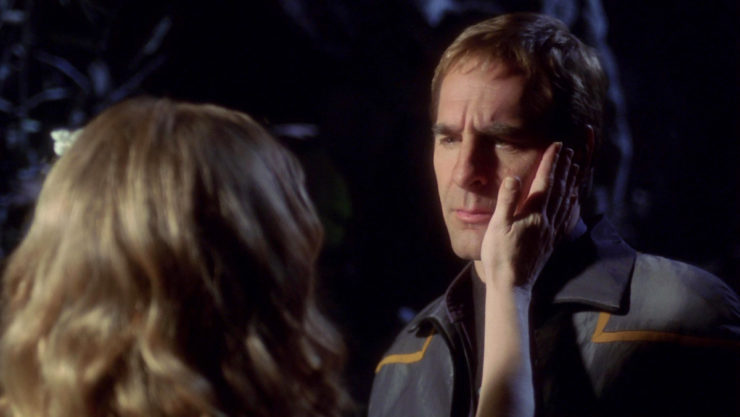
It’s been a long road… “We never failed in the hunt before you arrived.” The notion of a rogue planet is a fascinating one, and is exactly the kind of strange new world that would be fun to explore.
Unfortunately, there is precisely nothing in the story that requires it to be a rogue planet. In fact, after going to all the trouble of establishing that this is a planet without a star system, we get a bog-standard hunting story on a bog-standard jungle set, with three guest characters who are nominally alien, but may as well be three guys named Joe, Fred, and Billy-Bob from central Pennsylvania, given how they act.
There are hints of the interesting episode this could have been, but they drop the ball on all of them. The discussions on how humans don’t really hunt anymore don’t go anywhere, Sato’s presence points to maybe showing some difficulty in talking to the aliens, but they forego that and the universal translator works perfectly and effortlessly. The notion of a creature that can look like something from your memories could make for a good story—something like what the original series did in “The Man Trap“—but, while I do like that Archer’s “fantasy woman” is in fact from a Yeats poem his Mom read him, there are so many story possibilities that are just wasted here. I mean, Archer is just so blasé about the wraith getting in his head and digging around like that. And yes, Star Trek characters have their heads mucked with all the time, but in a prequel like this, it should be new and weird and scary, but Archer’s very been-there-done-that about it, which is just not that interesting.
And in the end, the problem is solved in a straightforward manner, the Eska pout at Archer for a bit, and that’s it. It’s only not anticlimactic because it’s of a piece with the rest of this dreary, goes-nowhere episode.
Warp factor rating: 3
Keith R.A. DeCandido will be an author guest at HELIOsphere 2022 this coming weekend. He’ll be doing panels and programs and things, and also spending time at eSpec Books’s booth in the dealer room. Click here for his schedule.




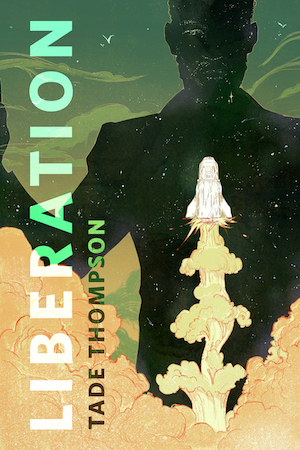





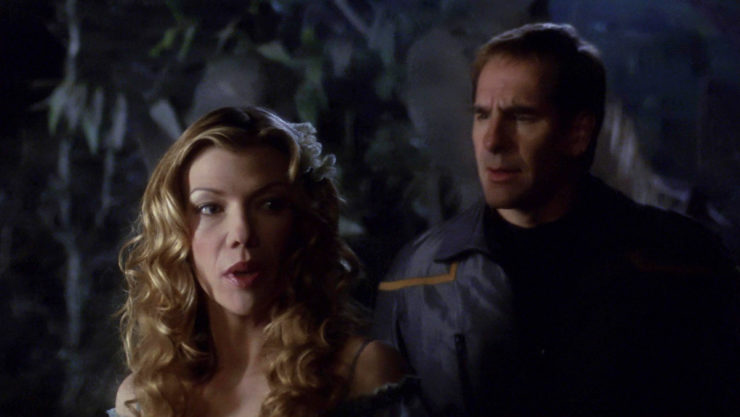
It’s amusing to me that in 2002, they thought 22nd-century humans would still need a dedicated device for taking photographs.
elcinco: That didn’t bother me nearly so much as the fact that Tucker’s digital camera looked exactly like the one I had in 2002…………..
—Keith R.A. DeCandido
I recognized guest actress Stephanie Niznik from her role as Nina on the excellent TV series Everwood, and was saddened to learn a few years ago that she had died.
It’s been a while since I saw this episode, but a few thoughts I remember having at the time. The wraith’s natural appearance as a giant slug cracked me up. And I also questioned how a planet without sunlight could grow such lush plant life. I get that they established that the planet had geothermal properties, which would explain how the planet could generate heat, but not how the planet could support plant life. I agree with Keith; the idea of a rogue planet is interesting, but nothing about this story necessitated the planet being a rogue planet.
Hey, why not, there are still photographers today who make tintypes.
@2, 4
Yes, I think the traditional Star Trek gloss for this would be to suggest that Trip is a paleophotography nerd who believes the art form peaked in 2002.
I was taking an old-fashioned photography course in college around this time, I think it was 2003, learning how to develop film in a darkroom and so forth, and I remember my teacher saying she thought digital would never replace traditional film photography.
Yeah, they no longer offer that class. But it was fascinating to be there during that transitional period.
Actually, they didn’t resolve their not-the-prime-directive problem. An entire planet. Archer acknowledges that they could have landed elsewhere, but they wanted to see who else was passing by. So whatever the good doctor produced, how many wraiths will it protect and for how long?
You mentioned TOS The Man Trap. I was wondering how the wraith-slugs developed that kind of ability. Is it a defensive chameleon, or is it an lure? How did Archer escape un-eaten?
And regarding the hunters, all appeared approximately like white males. Stocky to fat. Don’t tell me those aren’t racist stereotypes …
I assume hunters would stop going there when their trick failed.
Also fascinating, I didn’t know Elmer Fudd was considered a race.
“Hunting wild boar is one thing but they’re killing a sentient species.”
This starts off as a mystery episode, before morphing partway through into a morality play. Whilst I take the point that it’s named after something that’s just a passing detail, I enjoyed it more than Keith did. It’s nicely underplayed in certain ways. Archer and co again make peaceful contact with a group of aliens, and don’t make big speeches about their differences until they realise the Eska are crossing a line that they really can’t turn a blind eye to. Even then, they don’t act against them directly, although the episode seems to provide a bit of an easy answer by not having anyone die as a result of Enterprise’s actions. Maybe the wraiths made them a promise.
It’s a bit of a weakness that Damrus and his friends initially mock and dismiss Archer’s claim to have seen someone, only to suddenly start delivering exposition about the wraiths when we’ve reached the point in the episode for the mystery to be solved. (They don’t even know about Archer’s later encounters with the woman.) While Keith Szarbajka is as distinctly gravelly-voiced as ever, Eric Pierpoint is disappointingly anonymous as second Eska from the left. It’s not clear by the end how accurate Archer’s insistence that the Eska know the wraiths are more than lower animals actually is: Interesting that they consider “higher primates” off the table but consider mind-reading shapeshifters to just be creatures of instinct.
Some more great character moments. The opening of Tucker trying to get a good photo of Archer has nothing to do with the plot but it’s funny anyway, with T’Pol once more barely tolerating the silliness. There’s some good banter between Archer and Reed, as the captain insists on taking the lead and is slightly put to learn his armoury officer has more Scout badges than him (including exobiology!). And another good heart-to-heart between Archer and T’Pol, who have definitely mastered the art of disagreeing in a respectful manner since the start of the season.
Mayweather and Sato seem to be taking it in turns to be in charge while the grown-ups are away again: They both answer Archer’s calls at different times. Tucker notes the only time he’s known Archer be foolish was during a poker game at Jupiter Station.
On the concept of the Universal Translator working perfectly, don’t forget that we’re seeing another star faring species (who presumably have contacted other sentient species as well). My take is that hearing the conversation in English is just for the convenience of the viewer. Why couldn’t it be that the Eska have Universal Translators more advanced than what Starfleet has at this point?
As far as the Eska themselves (and the fact that the episode takes place in a jungle), these guys would be at home in a Louisiana Bayou on a boat hunting gators.
As far as the rogue planet itself, heat from radioactive decay and geological process could provide sufficient warmth that the atmosphere hasn’t frozen out. It would have been interesting to spend some time actually researching the planet including possible origin rather than spend the episode on a safari.
I actually like this one a lot. Stephanie Niznik is effectively ethereal as the wraith, though the “lady from a poem” explanation is a bit weird (why couldn’t it just have been his memory of how his mother looked in his childhood?). The use of a rogue planet as a setting did serve one purpose, to give us a purely nocturnal environment, which was at least a nice visual change of pace. It was nice to see the crew actually having night-vision gear, although it raises the question of why future Starfleet seems to forget it exists. It also has a really nice score by Paul Baillargeon.
One thing I particularly like is the acknowledgment that this is not Kirk’s or Picard’s Starfleet that has the power of the Federation to enforce law and justice; it’s just one ship of explorers with no status or authority to influence events, so they’re limited in what they can do to protect the wraiths. It’s an effective illustration of what makes this show different from previous Trek series, and I liked it when they played up those distinct elements. I also liked it as a student of history with a particular interest in the study of frontiers, regions of cultural contact and interaction outside the bounds of a single state’s direct authority or value system.
It was also nice to see a Trek show be on the cutting edge of science, since astronomers at the time were only just beginning to figure out that rogue planets were probably a thing. Current theory is that they’re probably extremely common; I think I read recently that current thinking is that there’s an average of at least one rogue planet ejected into interstellar space for every planetary system that forms in the galaxy. But at the time of this episode, they were a novel enough idea that many viewers found the episode’s premise implausible. They did take some liberties, though, since most rogue planets would have frozen surfaces and any life would probably be in sub-glacial oceans kept liquid by internal heat from the core. Still, they fudged it well enough for a Trek episode.
Why would they need Tucker to help out with the survey if there’s no technology? Does he have a botany hobby like Sulu does (will?)?
Big disappointment that this came from the science advisor. Either he just came up with the idea of a rogue planet and left it to the writers or he gave them details about what it would be like and they totally ignored it. Either way, lost opportunity to explore a strange, new world.
How are the wraiths supposed to make and distrusted Phlox’s treatment? Do they have the ability to make it from native materials?
@11 – One of the earliest, if not the earliest, mentions of a rogue planet was in the 1933 novel When Worlds Collide.
And they didn’t just fudge the concept, the filled it with marshmallow and sprinkled it with nuts. Seriously, a really cool concept that they did absolutely nothing with except for the perpetual night. They could have getten the same thing with a tidally locked planet that was only habitable on the dark side.
It’s actually plausible that some variant of photosynthesis could work off of infrared. Some cyanobacteria seem to use some infrared to photosynthesize here on Earth. Hence it’s possible that a planet with enough ambient heat could have “plants” in the absence of much visible light.
It almost certainly would not be green however. Black would make the most sense, since black objects absorb the most heat.
What’s wrong with central Pennsylvania?
I just wanted to note that the completely trivial and inconsequential factoid that this episode first aired March 20, 2002. That is twenty years plus 1 day ago.
Another episode with missed potential, but instead of the character moments that helped ameliorate other weak episodes, this episode gave use pretentious poetry. (Rogue Planet, safari, hunters, hallucinations, shape-shifters, so many potential ideas, too many perhaps.)
@11 – A Star Trek novel from 1977 called “Planet of Judgement” included a rogue planet. https://memory-alpha.fandom.com/wiki/Planet_of_Judgment
It’s almost as if the writers read an article about rogue planets in Highlights for Children and just ran with the idea.

@16/Bob: “A Star Trek novel from 1977 called “Planet of Judgement” included a rogue planet.”
I have that book on the shelf a meter to my right, and of course the concept has been around for considerably longer than that in both science and science fiction. I misspoke; I should have specified habitable rogue planets. It was always assumed that rogue planets couldn’t possibly have atmospheres or biospheres, and the inhabited rogue worlds that showed up in science fiction were always sustained by some artificial means, such as the miniature sun that orbited the world in Planet of Judgment, or the force field-like layer that held in the atmosphere of the rogue planet in Alan Dean Foster’s sequel story to “The Counter-Clock Incident” in Star Trek Log Seven from 1976.
What was novel at the time of this episode was the idea that rogue planets might naturally be able to hold onto atmospheres or liquid water. That idea was first proposed by planetary scientist David J. Stevenson in 1998, though his proposal involved planets with thick hydrogen atmospheres.
@17/bgsu: As Keith said, the idea came from the show’s science consultant Andre Bormanis, who has a physics degree and a masters in science, technology, and public policy, and has worked as a consultant for the Planetary Society.
As a Scout myself, I can say the first thing two Scouts do when meeting is not compare merit badge count but compare rank achieved, and if Eagle is achieved, what the service project was. I would say that this implies none of the writers were in Scouts for very long, but the BSA is notoriously protective of their copyrights and trademarks, so it’s likely they just didn’t have the rights to mention the names of the ranks (yes, the names of the ranks are copyrighted and/or trademarked, including Eagle Scout).
If they had it, I would totally have taken the Exobiology badge. Interestingly, there exists both the Astronomy badge and the Space Exploration badge (I earned both).
Devices that are solely cameras are still in use today. I believe professional photographers aren’t going to use cell phone cameras for their work. While cell phones are perfectly find for everyday casual use, they are highly inferior to a actual camera.
While I am not a photographer, I am, among other things, a costumer (cosplayer). I have never seen the official photographers at costume events (masquerades, balls,etc.) use anything but a professional level camera which has no other function other than taking, editing and, maybe, transmitting photographs.
Quoth kkozoriz: “And they didn’t just fudge the concept, the filled it with marshmallow and sprinkled it with nuts.”
For the record, I’m totally stealing this metaphor……
—Keith R.A. DeCandido
@18 – Yes, but as also pointed out, Bourmanis didn’t write it. And Trek writers often take advice from the science consultants and then totally screw it up.
It’s like all the writers did was hear the words “a rogue planet doesn’t orbit a star” and went “OK, so it’s dark. Got it”.
It reminds me of when Into Darkness used Carolyn Porco as a science consultant and then got what she said totally wrong. Why bother if you’re just going for “Looks kewl”?
I believe I once read that it’s plausible some rogue planets could form natural heliox type atmospheres (even in the absence of life). This would be interesting, because it would be very, very different from our own but the free oxygen levels could be high enough to be breathable.
A great setting for a show to highlight how alien a world could be while still allowing humans to be on the surface. A thick, soupy atmosphere almost more like a liquid than a gas. So much helium our voices would be pitched too high to easily understand. Pitch black except for the occasional lightening strike.
But no, Enterprise had a jungle planet.
Andre Bormanis also wrote “Demon” and “Extinction”, so while his credentials as a scientist may have been impeccable, his results as a writer were not. He should have put the pen down and stuck to advising on matters of science.
@19/Ecthelion of Greg: Funny you should mention that, because when I find out a friend or acquaintance was also an Eagle Scout, my first go-to is to merit badges. But then again, I was an overachiever in Scouts.
I am with CLB in liking this one alright. Sure, the science is…implausible, and the hunters are stereotypes, but the story was interesting enough to keep my interest, and I actually remember details about it weeks after watching it, which is more than I can say for several Enterprise episodes so far.
@23/Karl Zimmerman: “A great setting for a show to highlight how alien a world could be while still allowing humans to be on the surface. A thick, soupy atmosphere almost more like a liquid than a gas. So much helium our voices would be pitched too high to easily understand. Pitch black except for the occasional lightening strike.
But no, Enterprise has a jungle planet.”
I would totally be up for an episode where the landing party spends the whole time on the surface sounding like Alvin and the Chipmunks.
@24/bgsu98: “Andre Bormanis also wrote “Demon” and “Extinction”, so while his credentials as a scientist may have been impeccable, his results as a writer were not. He should have put the pen down and stuck to advising on matters of science.”
That’s unfair. The credited writer in a TV show is just one of many hands that work on a script, and the showrunner always does the final draft. It’s well-documented that Bormanis wanted the crew to be low on dilithium in “Demon” but was overruled by Berman and/or Braga, who thought having the ship be “out of gas” was funny enough to justify the absurdity of a deuterium shortage.
@25/David Pirtle: The point I was trying to make is that the science was far less implausible than it seemed to many viewers at the time, because the scientific understanding that rogue planets might be common and potentially habitable was still quite new, so many people took the plausible parts of the premise for flights of fancy. Having surface habitability and jungle vegetation was a bit of a stretch, but an understandable one given the production limitations of a TV series.
In my book, the episode scores points just for having a rogue planet instead of just another planet in the habitable zone of a Sunlike star. It’s so rare to see any hint in screen sci-fi of the kind of planetary diversity we now know to exist.
@24bgsu98: I guess different different people value different things more when it comes to that. I know I couldn’t tell you off the top of my head how many badges I earned, but I will always remember my service project was building shelves for a homeless shelter.
Stephanie Niznik (RIP) was always good in her roles. Everwood comes to mind, and of course Insurrection. I wish they’d brought her back to Nemesis. Still, she had some nice chemistry with Bakula.
But even with the intriguing concept of a rogue planet, this episode still feels lifeless. Even though Archer’s connection to the wraith comes from an interesting place, the whole thing still plays way too much by the book. There’s no surprise in the story. You know the Eska are going to be thwarted somehow.
It feels very much like classic Trek on autopilot, which goes to what I’ve been saying regarding Enterprise’s mid-season choice to abandon the more interesting character-centric stories in favor of this plot-driven approach. There’s a reason Chris Black was the only writer to survive season 1’s mass staff exodus, and it’s because he was easily able to adapt to doing the kind of Star Trek stories that have been done to death by this point. And I guess Kroeker was having an off day. He’s directed way better episodes before and after.
@@@@@ 21 – krad – With my complements.
@@@@@ 26 – “In my book, the episode scores points just for having a rogue planet instead of just another planet in the habitable zone of a Sunlike star.”
And just what was different from a planet in the HZ other than the fact it was dark? You could have had the exact same show if it were tidally locked or had a slow rotation.
It was literally the least they could do with the concept of a rogue planet. It was warm enough that they didn’t even need a jacket.
@@@@@ 28 – “There’s no surprise in the story. You know the Eska are going to be thwarted somehow.”
That’s why, for me, the best Star Trek stories are ones like Devil in the Dark and Errand of Mercy. Not only is there a twist to the story, it’s the humans that learn something as opposed to being the ones telling the aliens what they’re doing wrong. All too often Trek turns into the story of “missionaries for humanity”, telling all who they meet just how swell humanity is and why they should be more like us.
I’m with Mr Bennett on this one; it’s not an especially substantial episode, but I enjoyed the ambience and a chance for a bit of a breather – for the record, one tends to believe that they deliberately used one of the stronger high concepts for a planetary setting precisely because the rest of the episode is somewhat generic (to help spice things up a little).
Also, @11. ChristopherLBennett, I tend to assume that the “Wraith” picked that particular mental image precisely because it was associated with Mother Archer (I’d be very surprised if Baby Archer’s mental image of the Lady from that Poem were not, in part, based on his own mother) without being so specific that Archer would see through it in a minute and be angry or offended.
Just imagine how how creepy it would be to deal with something so profoundly alien hiding itself behind a familiar & beloved face … not exactly conducive to Human sympathy, eh?
Also, it makes perfect sense that the Wraiths would prefer to avoid their hunters, where possible; after all, their strongest natural defence is concealment & camouflage – and there’s ample reason to believe it’s the hunters who are the aggressors (Since they’re the ones who go out of their way to hunt the residents of this Rogue World).
This is one of the episodes that I really wish could have been done in animation, or at least using the “real-life holodeck” technology that they used on season 4 of Discovery. The idea of an entire planetary ecology that has evolved in the complete absence of light could be really cool if they had taken it seriously/had the budget to show it, but instead it’s just a jungle of clearly photosynthetic plants.
the only thing i remember from this episode, was me being upset that if they had night vision equipment in this era, where did it disappear later on? many TNG episodes would have benefitted from such devices, instead of very inconvenient hand-carried torches.
@34/th1_: I wonder the same thing about the security armor and seat restraints in the TOS movies, which had disappeared by the TNG era. Then there’s “Minefield,” where Reed’s spacesuit automatically seals itself after a rupture, but two centuries later, Worf in First Contact has to tie a suit rupture off by hand (in a way that I doubt would actually work in vacuum conditions).
Fictional depictions of the future are only as good as the imagination and knowledge of the storytellers. It’s natural that a later story would feature more advanced tech even when it’s set earlier. (Compare Strange New Worlds tech to TOS, for instance.)
@35/ ChristopherLBennett:
The reason i’m more upset about the night vision is because it was a long existing technology in the 80s…so it’s not some imagined future tech that someone needs to invent, while self sealing spacesuits are not in use yet…so I more easily forgive that First Contact writers did not think of it.
I totally disagree. I rather like this episode, maybe because I’ve got a bit of pagan poet in me. To me it just worked, and if the solution was too easy, well, I don’t mind because it went to a good place. A few things that I thought were really strong:
The music – I’ve criticized the show’s “bum bum tinkle” music in past episodes, but here the wraith theme was quite pretty.
The ship – With no light reflected from the planet it was dark. That was cool.
The mythology – This really did feel like something half out of a Greek myth with a hunter going after an animal that turns into a woman (only, here it’s the other way around).
The justice – I mean, the crew wasn’t wrong.
The call out – Already mentioned by KRad, but T’Pol’s line about Archer not doing the same for a scantily clad man, was a call out of sexism in general, and Trek’s in particular.
The poetry – Also already mentioned, but if you can pull Yeats and childhood ideation into a story, I’m already half way sold.
I just feel it’s a beautiful episode. Some faults, sure, but one that worked on a kind of magic level Trek doesn’t often do.